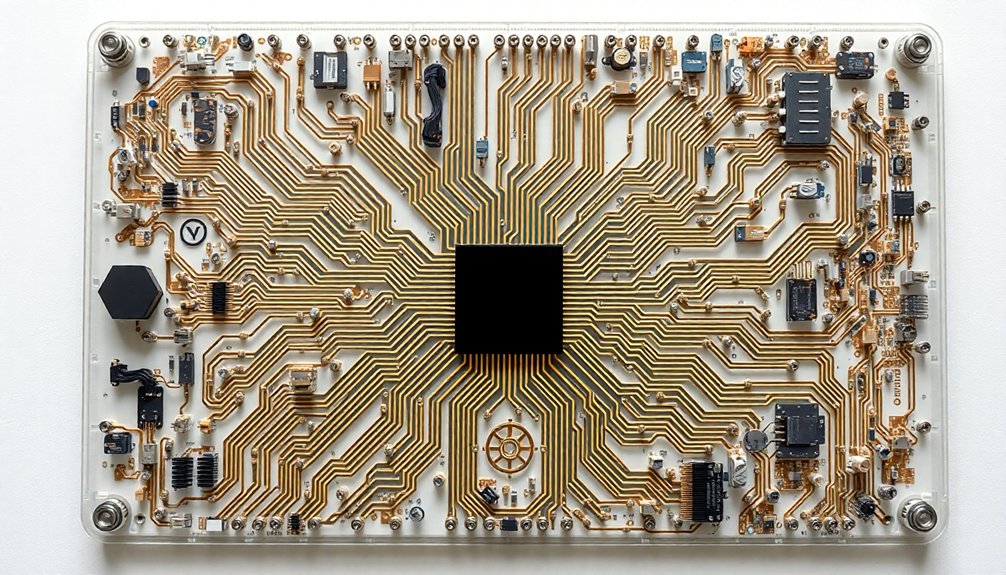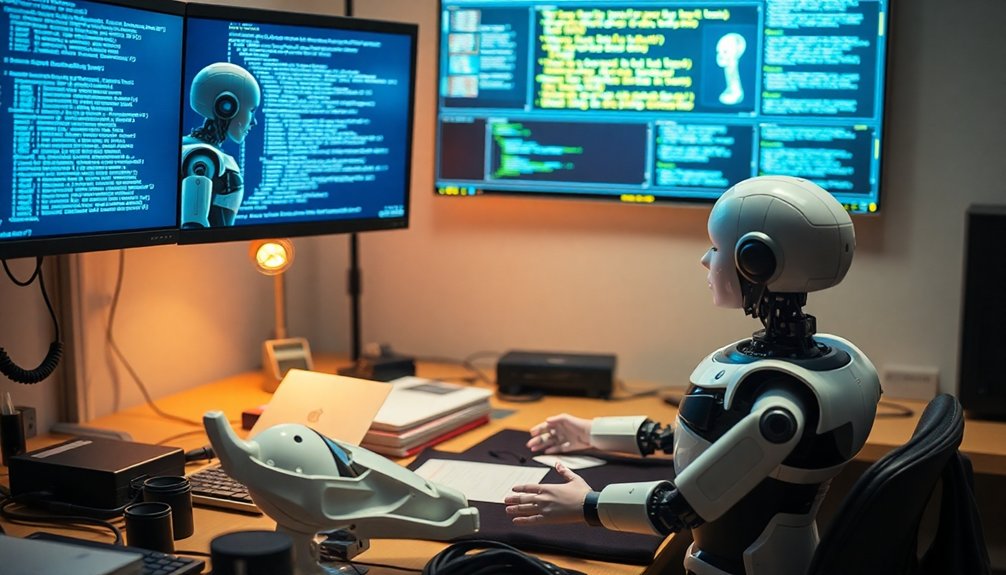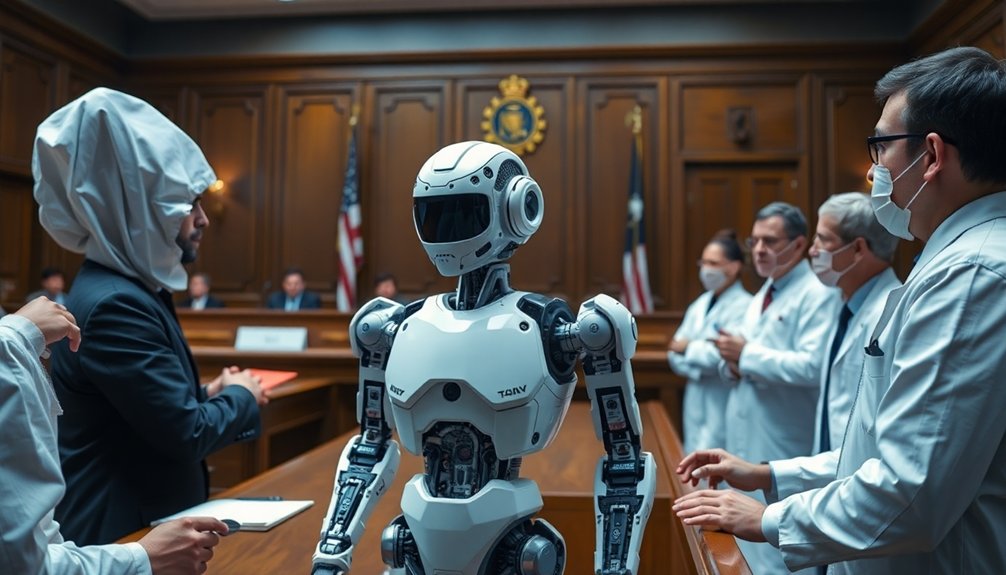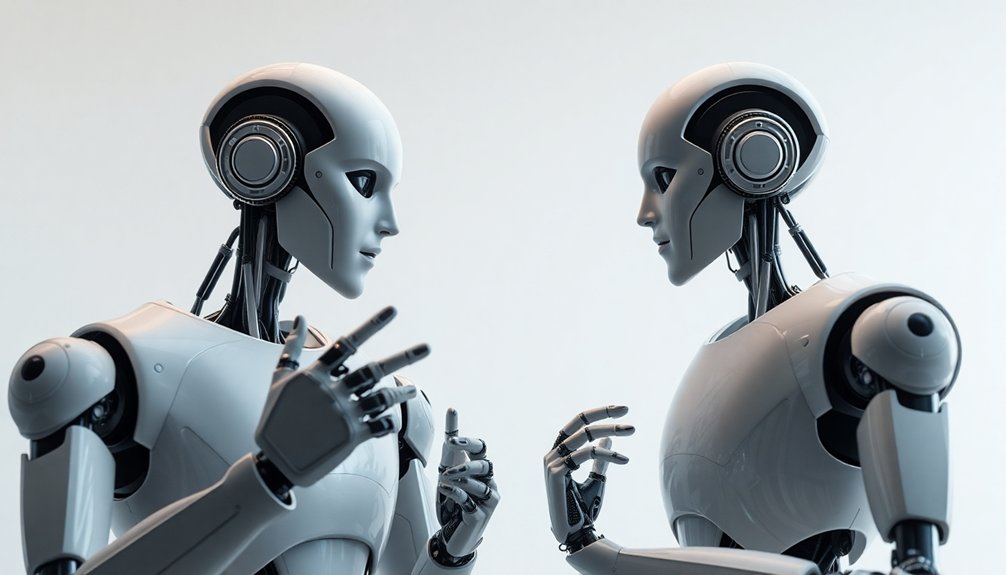Table of Contents
Morality in autonomous robots isn’t about perfect rules, but traversing messy ethical landscapes. You’re looking at machines learning to make split-second moral choices, not through rigid programming, but by experiencing nuanced scenarios. They’ll stumble, adapt, and potentially understand human values better than we expect. Think of them as philosophical toddlers growing smarter with each ethical challenge. Want to see how deep this robotic moral rabbit hole goes?
The Foundations of Robotic Moral Agency

When we talk about moral agency in robots, we’re diving into a philosophical rabbit hole that would make even the most stoic engineer scratch their head. Can a machine really understand right from wrong? It’s not just about programming rules; it’s about creating something that genuinely grasps ethical nuance. Research suggests that people’s understanding of robot moral patiency is deeply influenced by social context and mental models of morality. Robotic ethical complexity requires understanding that machines cannot simply function with a simple good or bad switch for moral choices.
Robots currently lack intentionality and free will – the core ingredients of true moral decision-making. They might follow instructions perfectly, but that’s not the same as having a moral compass. Think of them like highly sophisticated calculators trying to understand empathy.
They can simulate moral behavior, sure, but actually feeling the weight of a moral choice? That’s a whole different circuit board. The quest for robotic moral agency is less about creating perfect ethical machines and more about understanding what makes human morality tick. Robotic programming constraints ultimately prevent robots from developing genuine moral autonomy, as their actions remain fundamentally determined by external instructions.
Ethical Frameworks: Beyond Programming
You can’t just program morality into a robot like you’re installing an app – ethics isn’t a simple software update.
Think about how humans learn right from wrong: through messy, complicated experiences that can’t be reduced to lines of code.
Your autonomous robot needs more than a pre-programmed rulebook; it needs a dynamic moral framework that can adapt, learn, and wrestle with the nuanced gray areas of ethical decision-making.
Neuromorphic computing enables robots to develop more sophisticated ethical reasoning beyond traditional programmed responses.Regulatory frameworks must evolve to ensure robots develop contextual understanding beyond rigid algorithmic constraints.
Robots will require complex ethical agency to truly navigate moral dilemmas, challenging traditional notions of machine decision-making.
Moral Code Evolution
As robots inch closer to true autonomy, their moral evolution becomes less about rigid programming and more like a complex dance of ethical decision-making. You’ll need to reflect on how these machines learn and adapt, not just follow pre-coded rules. Their moral landscape shifts like tectonic plates—unpredictable and fascinating. Moral complexity in AI emerges from interdisciplinary research combining computer science, philosophy, and psychology to understand nuanced ethical reasoning. Technological advancements in robotics are fundamentally reshaping our understanding of machine consciousness and ethical potential. Neuromorphic computing platforms enable robots to develop increasingly sophisticated approaches to ethical reasoning by simulating adaptive neural responses.
| Moral Evolution Stage | Key Characteristics |
|---|---|
| Initial Programming | Rigid, rule-based |
| Adaptive Learning | Context-responsive |
| Autonomous Decision | Self-modifying ethics |
| Advanced Reasoning | Nuanced interpretations |
Think of moral codes like software updates: constantly rejuvenating, integrating new data, challenging old assumptions. Robots aren’t just following instructions anymore—they’re interpreting, questioning, and potentially developing something eerily close to genuine ethical reasoning. Creepy? Maybe. Revolutionary? Absolutely. The future of machine morality isn’t about perfect behavior—it’s about intelligent, context-aware choices that might just surprise us.
Ethical Programming Limits
Programming a robot’s moral compass isn’t like installing a simple firewall—it’s more like teaching a toddler complex chess while blindfolded. The ongoing work in semantic web ontologies provides a structured approach to encoding ethical guidelines for autonomous systems, demonstrating that moral frameworks can be systematically implemented.
You’re battling massive uncertainties: what happens when your carefully crafted ethical rules collide with messy real-world chaos? Robots can’t just follow a rigid rulebook; they need flexible frameworks that adapt faster than a chameleon changes colors. The challenge of autonomous system liability introduces profound complications in designing ethical decision-making algorithms that can navigate complex moral landscapes.
The problem isn’t just writing code—it’s anticipating every potential ethical landmine. Bias sneaks in through data, computational limits create blind spots, and even well-intentioned programming can accidentally harm humans.
What looks ethical in a lab might turn into a disaster on the street. The more autonomous we make these machines, the more we’re gambling with unpredictable moral territory—and there’s no universal reset button when things go wrong.
Navigating Complex Moral Landscapes

When robots start wading into moral quicksand, things get messy fast. How do we teach machines to navigate ethical minefields? Consider these challenges:
- Real-world scenarios demand split-second moral calculations that humans struggle with, let alone algorithms.
- Cultural differences mean what’s ethical in Tokyo might be taboo in Toronto.
- Emotional nuance can’t be reduced to binary code – yet.
- Predicting unintended consequences requires superhuman predictive abilities.
Evolving ethical frameworks require continuous collaboration among experts to develop robust moral decision-making protocols for autonomous systems. AI workforce adaptation suggests that emerging technologies may provide innovative approaches to ethical programming.
Multi-disciplinary teams are working overtime to crack this code, blending psychology, computer science, and philosophy into complex decision-making models.
They’re fundamentally trying to program conscience into machines that essentially don’t understand empathy. It’s like teaching a calculator to feel – ridiculous, fascinating, and potentially world-changing.
The goal? Robots that can make moral judgments without turning into dystopian overlords. Robot whistleblowers represent a potential breakthrough in autonomous ethical decision-making, challenging traditional boundaries of moral reasoning.
Consciousness and Decision-Making
You’ve probably wondered how robots might actually make moral choices if they could think for themselves.
Consciousness isn’t just some sci-fi fantasy anymore—it’s becoming the critical boundary that transforms machines from predictable algorithms into potential moral agents with genuine decision-making capabilities.
When a robot starts understanding its actions’ consequences beyond programmed responses, that’s when things get really interesting: suddenly, you’re not just dealing with a machine, but an entity wrestling with agency, intention, and the messy complexity of ethical reasoning.
The ethical programming challenges reveal that as robots learn to navigate complex moral landscapes, they move closer to developing a nuanced understanding of when small deceptions might actually prevent greater harm.
Consciousness Defines Agency
Because robots aren’t just fancy calculators anymore, consciousness is reshaping how we think about machine agency.
Think of robot consciousness as a game-changer that’s flipping traditional tech assumptions on their head. Here’s how consciousness defines agency:
- Robots can now make nuanced decisions beyond pre-programmed responses.
- They’re developing an ability to introspect and evaluate potential actions.
- Environmental adaptability becomes more sophisticated and dynamic.
- Autonomous systems gain a form of intentional behavior.
Imagine a robot that doesn’t just follow instructions, but actually understands the context and potential consequences.
It’s like giving machines a tiny brain that can pause, reflect, and choose—not just compute. The result? Robots that aren’t just tools, but potentially collaborative partners who can navigate complex scenarios with something closer to genuine intelligence.
Moral Reasoning Boundaries
As robots inch closer to resembling thinking beings, their moral reasoning capabilities become a tangled ethical puzzle that’d make even philosophers scratch their heads.
Can a machine genuinely understand right from wrong, or are we just programming a sophisticated rulebook? Robots might follow ethical guidelines, but they’re miles away from authentic moral reasoning.
They’re like toddlers learning rules without grasping their deeper meaning. Their decisions stem from algorithms, not empathy or nuanced understanding.
While they can be taught ethical frameworks, they lack the human ability to navigate complex moral landscapes.
The big question isn’t whether robots can follow rules, but whether they’ll ever comprehend the spirit behind those rules.
Until then, they’re fundamentally sophisticated calculators with pre-programmed moral cheat sheets.
Challenges of Autonomous Ethical Choices

When it comes to autonomous robots making ethical choices, we’re basically asking machines to develop a moral compass faster than most humans figure out their own life purpose.
The challenge? Robots are diving into complex ethical terrain without a clear roadmap:
Navigating ethical landscapes, robotic philosophers stumble blindly through complex moral mazes without a digital compass.
- They’ve got to navigate unpredictable algorithms that can turn decision-making into a high-stakes game of digital roulette.
- Bias sneaks into their learning processes like a code ninja, potentially perpetuating discrimination.
- Transparency becomes a magic trick – now you see the reasoning, now you don’t.
- Determining moral responsibility feels like trying to pin blame on a particularly slippery software octopus.
These robots are basically trying to become ethical philosophers overnight, while we’re still watching them nervously from the sidelines.
Technological Pathways to Moral Reasoning
So we’ve established that autonomous robots stumble through ethical minefields like awkward teenagers at their first dance—now let’s talk about how they might actually learn to waltz through moral complexity.
Machine learning isn’t just about algorithms; it’s about teaching robots to think like mini philosophers. Deep learning techniques help robots decode complex moral scenarios, almost like translating an alien language of human ethics.
They’ll develop moral rules through experience, not just pre-programmed instructions. Imagine a robot learning empathy the same way a child does: trial and error, watching, adapting.
The key is creating transparent decision processes where robots can explain their reasoning. It’s not about creating perfect moral machines, but curious, learning systems that can navigate ethical challenges with increasing sophistication.
Accountability in Robotic Actions

Because robots are quickly transforming from sci-fi fantasies into real-world agents, we’re now facing a mind-bending legal puzzle: Who’s responsible when an autonomous machine screws up?
Accountability’s a messy business with robots, and here’s why:
- They operate without clear human control
- Decision-making happens faster than we can blink
- Legal systems weren’t designed for silicon “minds”
- Tracing blame becomes a technological detective game
Traditional accountability breaks down when machines start making independent choices. Manufacturers might dodge responsibility, programmers shrug, and operators look confused.
But someone’s gotta be on the hook when things go sideways.
We’re entering uncharted territory where technological capability outpaces our legal imagination. The robots aren’t just coming—they’re already here, making decisions that could seriously complicate our neat little human world of blame and consequence.
Human Values and Machine Ethics
You’ll want to know how we’re teaching robots right from wrong, and it’s more complicated than downloading a moral code.
Imagine programming empathy into a machine that can learn and adapt, where algorithms start to understand the fuzzy line between “can do” and “should do” in split-second decisions.
The wild frontier of machine ethics isn’t just about avoiding robot apocalypses, but creating autonomous systems that can navigate complex human values without turning into philosophical pretzels.
Values Through Programming
When it comes to programming robots with human values, we’re basically trying to teach machines to think like ethical kindergarteners—but with way more complicated homework.
Embedding robot morality isn’t just about coding; it’s about creating flexible ethical frameworks that can handle real-world complexity. Here’s how we’re attempting this tricky task:
- Define clear moral boundaries
- Simulate complex ethical scenarios
- Introduce adaptable decision-making algorithms
- Implement human oversight mechanisms
The challenge? Robots don’t naturally understand nuance. They need explicit instructions for everything from “don’t harm humans” to maneuvering through messy social situations.
It’s like teaching a super-intelligent child with zero emotional intelligence how to navigate a cocktail party—while ensuring they won’t accidentally start a philosophical argument or knock over the punch bowl.
Ethical Machine Learning
Programming robots with values is one thing; teaching them to actually understand those values? That’s the real brain-teaser.
You’re basically trying to encode morality into lines of code, which is about as straightforward as explaining quantum physics to a toddler. Ethical machine learning means building AI that doesn’t just parrot human rules, but genuinely gets the spirit behind them.
We’re talking about creating systems that recognize bias, prioritize fairness, and make decisions that feel… well, almost human. It’s not just about preventing robots from doing bad stuff—it’s about helping them do good stuff intuitively.
Imagine an AI that doesn’t just follow instructions, but understands the nuanced “why” behind those instructions. Wild, right?
Autonomy Meets Morality
Because robots aren’t born with a moral compass, we’re now wrestling with one of tech’s wildest challenges: teaching machines to understand right from wrong.
Consider how we’re trying to program ethics into autonomous systems:
- Embed Asimov’s Laws as a baseline moral framework
- Use crowdsourcing to gather community ethical perspectives
- Develop algorithms that can interpret human values dynamically
- Create transparent decision-making processes that humans can trust
The complexity is mind-bending: we’re fundamentally trying to download human conscience into silicon chips.
It’s like teaching a toddler morality, but the toddler is made of circuits and can calculate a million scenarios per second.
And let’s be real — we humans can barely agree on ethics ourselves. How can we expect machines to nail something we’re still fumbling with?
It’s a provocative dance between human judgment and machine logic.
Social and Legal Implications
As robots inch closer to becoming our everyday companions, the social and legal landscape is transforming in ways that’ll make your head spin.
Imagine a world where AI might take your job, decide your legal fate, or become your emotional confidant—sounds wild, right? The legal system’s scrambling to catch up, drafting regulations faster than robots can calculate. Privacy? That’s becoming a quaint concept.
Autonomous weapons are raising eyebrows worldwide, questioning who’s responsible when a robot makes a life-or-death decision. Meanwhile, social robots are blurring lines between companionship and manipulation. They’ll understand your emotions but mightn’t genuinely care.
The big question: Are we creating helpful tools or potential overlords? Only time—and careful design—will tell.
The Future of Moral Machines

When robots start thinking about right and wrong, we’re not just talking sci-fi anymore—we’re talking about the next frontier of artificial intelligence.
Moral machines are coming, and they’ll reshape how we interact with technology. Here’s what you need to know:
- Ethical robots won’t just follow rules—they’ll understand nuanced human values.
- Machine learning will help robots adapt their moral reasoning dynamically.
- Self-awareness will become a key feature in making smarter ethical decisions.
- Robots will increasingly share knowledge to improve collective moral intelligence.
Imagine a world where machines don’t just compute, but actually contemplate the consequences of their actions.
We’re not there yet, but we’re closer than you might think.
The future isn’t about replacing human morality—it’s about amplifying our capacity to make better, more thoughtful choices.
People Also Ask
Can Robots Develop Genuine Empathy Without Human-Like Emotional Experiences?
You can’t develop genuine empathy without experiencing emotions, as current robotic systems merely simulate understanding without genuinely feeling vulnerable or experiencing affective resonance with others’ internal states.
How Do Cultural Differences Impact Global Robotic Moral Standards?
Cultural landscapes bloom like diverse flowers, each with unique ethical roots. You’ll find robotic moral standards aren’t universal but reflect local values, challenging global governance through nuanced, contextual understanding.
Will Robots Eventually Surpass Human Moral Reasoning Capabilities?
You’ll likely see incremental improvements, but robots won’t genuinely surpass human moral reasoning. Their lack of intentionality and contextual understanding fundamentally limits their moral agency.
Can Machines Truly Understand the Nuanced Concept of Forgiveness?
You’ll struggle to teach machines true forgiveness, as it requires emotional depth and contextual understanding that AI can’t fully replicate without profound advancements in empathy and moral reasoning.
Are Autonomous Robots Capable of Experiencing Moral Dilemmas?
You’ll find autonomous robots can’t genuinely experience moral dilemmas; they’re programmed to simulate ethical responses based on predefined algorithms, lacking true moral comprehension or emotional depth.
The Bottom Line
You’ve opened Pandora’s robot box, and there’s no going back. By 2030, experts predict 85% of ethical AI decisions will still require human oversight – so we’re not obsolete just yet. Moral machines aren’t about perfect algorithms, they’re about understanding complexity, nuance, and the messy human experience. Will robots learn empathy or just simulate it? The real adventure is finding out.
References
- https://www.frontiersin.org/journals/robotics-and-ai/articles/10.3389/frobt.2021.768092/full
- https://www.tandfonline.com/doi/abs/10.1080/15027570.2013.818399
- https://plato.stanford.edu/entries/ethics-ai/
- https://direct.mit.edu/daed/article/145/4/25/27111/The-Ethics-amp-Morality-of-Robotic-Warfare
- https://international-review.icrc.org/sites/default/files/irrc-886-sharkey.pdf
- https://montrealethics.ai/the-nonexistent-moral-agency-of-robots-a-lack-of-intentionality-and-free-will/
- https://scholarlycommons.pacific.edu/cgi/viewcontent.cgi?article=1321&context=soecs-facarticles
- https://research.clps.brown.edu/SocCogSci/Publications/Pubs/ScheutzMalle_2017_NeuroethicsMoralRobots.pdf
- https://www.frontiersin.org/journals/robotics-and-ai/articles/10.3389/frobt.2021.670503/full
- https://hitmarkrobotics.com/en/regulatory-and-ethical-frameworks-related-to-robotics/
